Plastic Island, The Great Pacific Garbage Patch, Trash Island: whatever you call it, this massive accumulation of ocean plastic pollution located between Hawaii and California is growing bigger day-by-day.
Situated halfway between Hawaii and California, the Great Pacific Garbage Patch stands as the largest among the five major offshore plastic accumulation zones found in the world’s oceans.
Every year, an estimated 1.15 to 2.41 million tonnes of plastic make their way into the ocean through rivers. Surprisingly, over half of this plastic has a lower density than water, causing it to float instead of sinking upon entering the sea.
The durable and buoyant nature of certain types of plastic enables them to withstand the marine environment and travel long distances. These plastics remain on the sea surface as they are carried by converging currents, eventually accumulating in the Great Pacific Garbage Patch.
Once within the north pacific subtropical gyre, these plastics tend to remain there until they break down into smaller microplastics due to exposure to sunlight, waves, and interactions with marine organisms. With the continuous influx of plastic waste, the concentration of microplastics in the Great Pacific Garbage Patch is expected to rise steadily.
The location and shape of the Great Pacific Garbage Patch undergo constant changes due to the seasonal and yearly fluctuations of winds and currents. Objects that float and are primarily affected by currents rather than winds are more likely to remain within the patch.
But what is it made from? Where does it come from? And what can be done about it? For answers to these questions and more, keep reading…
- 1. It was discovered by oceanographer and boat captain Charles Moore
- 2. It is roughly three times the size of France
- 3. Fishing nets account for around 45% of the Great Pacific Garbage Patch
- 4. The Great Pacific Garbage Patch is just one of five similar patches
- 5. Once plastic enters the patch, it is unlikely to ever escape
- 6. The Great Pacific Garbage Patch contains between 1.1 to 3.6 trillion pieces of plastic
- 7. The plastic does not just exist on the surface of the patch, but underwater as well
- 8. Plastic will account for roughly 74% of the diet of sea turtles that enter the area
- 9. It contains plastic that is decades old
- 10. The largest ocean cleanup in history is underway to try to remove plastic from the ocean
- Risks to human health and the economy
- What to do about the marine debris problem in the pacific ocean
- The Great Pacific Garbage Patch FAQ
1. It was discovered by oceanographer and boat captain Charles Moore
Key takeaways:
-
The great pacific garbage patch was discovered by oceanographer captain Charles More in 1997
-
A colleague of Moore’s dubbed the vast area of ocean plastic pollution the ‘Great Pacific Garbage Patch’
In 1997, Oceanographer and boat captain Charles Moore was sailing his boat home to California after completing the Los Angeles to Hawaii Transpac sailing race.

When Moore and his crew were sailing through the North Pacific Subtropical Gyre, one of the most remote parts of the pacific ocean, they observed large amounts of marine debris floating in the ocean. Moore later wrote of his discovery:
“As I gazed from the deck at the surface of what ought to have been a pristine ocean, I was confronted, as far as the eye could see, with the sight of plastic. It seemed unbelievable, but I never found a clear spot. In the week it took to cross the subtropical high, no matter what time of day I looked, plastic debris was floating everywhere: bottles, bottle caps, wrappers, fragments.”
A colleague of Moore’s dubbed the vast area of ocean plastic pollution the ‘Great Pacific Garbage Patch’, and the name has stuck ever since.
Charles Moore now works at the Algalita Marine Research and Education in California, an organisation dedicated to “giving young people the opportunity to take up the charge against plastic pollution.”
2. It is roughly three times the size of France
Key takeaways:
-
It is not in fact an island, but rather a vast area containing ocean debris.
-
The patch covers an estimated surface area of 1.6 million square kilometers or twice the size of Texas.
-
The location of the patch can vary over time.
There’s a common misconception when it comes to the Great Pacific Garbage Patch: that it’s an actual island. This misconception probably comes from the fact that it is sometimes called ‘plastic island’. It is not an island, rather it is a huge patch of ocean that contains a high concentration of plastic debris.
The patch covers an estimated surface area of 1.6 million square kilometers. That’s twice the size of Texas, or three times the size of France. The patch cannot be seen from space, as is sometimes claimed.
Making things more complicated, the location of the patch can vary over time, depending on the time of year.
3. Fishing nets account for around 45% of the Great Pacific Garbage Patch
Key takeaways:
-
According to a recent study, 46% of the Great Pacific Garbage Patch is made up of fishing nets.
-
One of the problems with discarded fishing gear is that it can continue to catch marine animals long after being abandoned.
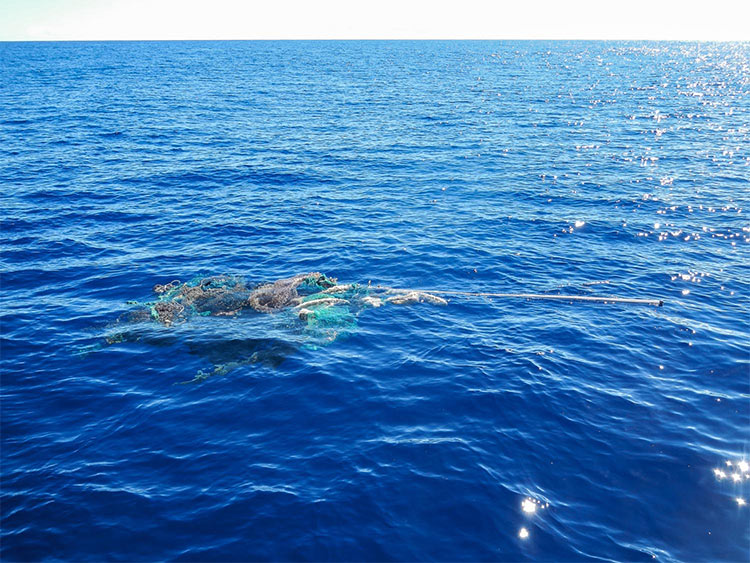
When discarded fishing gear becomes abandoned or lost, it becomes known as ‘ghost gear’. According to a recent study, 46% of the Great Pacific Garbage Patch is made up of fishing nets. Laurent Lebreton, the lead author of the study, explained to National Geographic:
“I knew there would be a lot of fishing gear, but 46 per cent was unexpectedly high. Initially, we thought fishing gear would be more in the 20 per cent range. That is the accepted number [for marine debris] globally—20 per cent from fishing sources and 80 per cent from land.”
One of the problems with ghost gear is that it can continue to catch marine animals long after being abandoned. When a piece of discarded fishing nets captures an animal, it is known as a ‘ghost catch’.
Marine life that is unfortunate enough to enter the Great Pacific Garbage Patch, such as fish, sea turtles and dolphins, are at serious risk of becoming ensnared by a piece of ghost gear.
4. The Great Pacific Garbage Patch is just one of five similar patches
Key takeaways:
-
The Great Pacific Garbage Patch is found within the North Pacific Gyre, which is one of five major ocean gyres in the world.
-
The other major ocean gyres are The Indian Ocean Gyre, The North Atlantic Gyre, The South Atlantic Gyre and The South Pacific Gyre.
-
Every major ocean gyre has a garbage patch.

The Great Pacific Garbage Patch is found within the North Pacific Gyre, which is one of five major ocean gyres in the world.
The definition of an ocean gyre, as per Wikipedia, is: “any large system of circulating ocean currents, particularly those involved with large wind movements. Gyres are caused by the Coriolis effect; planetary vorticity along with horizontal and vertical friction”
The other major ocean gyres are The Indian Ocean Gyre, The North Atlantic Gyre, The South Atlantic Gyre and The South Pacific Gyre.
Although the Great Pacific Garbage Patch is the largest and most densely polluted ocean patch in the world, it is by no means the only garbage patch in the world. Every major ocean gyre has a garbage patch. For example, the North Atlantic Garbage Patch is estimated to be hundreds of miles across and contains over 200,000 pieces of plastic debris per square kilometer.
In one scientific study, it was estimated there are between fifteen and fifty-one trillion individual pieces of microplastic in the world’s oceans. By comparison, there are between 150 – 250 billion stars in our galaxy.
5. Once plastic enters the patch, it is unlikely to ever escape
Key takeaways:
-
The North Pacific Subtropical Gyre is a circular movement of ocean currents that make it very difficult for marine debris to ever escape the Great Pacific Garbage Patch.
-
Ocean gyres are caused by the Coriolis Force (the rotation of the Earth) and the wind patterns.

The reason why debris accumulates in these areas can be explained by looking at what the north pacific subtropical gyre actually is. An ocean gyre acts as a huge circular conveyor belt. It means that once debris enters the gyre, it is very difficult for it to escape, due to the circular nature of the currents.
The North Pacific Subtropical Gyre is created by the clockwise rotation of four currents covering an expansive area of 20 million square kilometers (7.7 million square miles). These currents include the California current, the North Equatorial current, the Kuroshio current, and the North Pacific current.
Within the gyre, the central region experiences a state of tranquility and stability. The circular movement of the gyre attracts marine debris towards this stable center, effectively trapping it in place.
Ocean gyres are caused by the Coriolis Force (the rotation of the Earth) and the wind patterns. Gyres help circulate water around the globe, which is essential for regulating temperature, salinity and nutrient flow in the world’s oceans.
Ocean gyres have been circulating water around the world for millions of years. In recent years though, as well as circulating water around the globe, they have begun to act as trash vortexes, pulling in marine debris and not allowing it to escape.
6. The Great Pacific Garbage Patch contains between 1.1 to 3.6 trillion pieces of plastic
Key takeaways:
-
When exposed to sunlight, plastic breaks into smaller and smaller pieces, until they are classed as microplastics.
-
It is estimated that there are 1.8 trillion plastic pieces floating in the patch. This amounts to approximately 250 pieces of debris for every individual on the planet.
-
If the entire patch, including the outer region, is taken into account, the total mass would be closer to 100,000 tonnes.

During the sampling process conducted by TheOceanCleanup, it was discovered that the Great Pacific Garbage Patch (GPGP) contained over 1.8 trillion pieces of plastic, weighing approximately 80,000 tonnes. These numbers represent a significant increase compared to previous calculations. In fact, the estimated mass of plastic in the GPGP is 4-16 times higher than previously thought and is equivalent to the weight of 500 Jumbo Jets.
The density of plastic is highest at the center of the GPGP, gradually decreasing towards the outer boundaries. When determining the mass, the research team focused on the denser central area, excluding the less-dense outer region. If the entire patch, including the outer region, was taken into account, the total mass would be closer to 100,000 tonnes.
In addition to the mass, it was estimated that there are 1.8 trillion plastic pieces floating in the patch. This amounts to approximately 250 pieces of debris for every individual on the planet. The team used a conservative approach to estimate the plastic count, considering a range of 1.1 to 3.6 trillion pieces as a possibility.
These updated findings provide a clearer understanding of the immense scale of plastic pollution in the Great Pacific Garbage Patch.
To understand why there are so many, it’s important to understand the way in which plastic decays. It does not biodegrade in the same way that a piece of fruit would.
Rather, plastic undergoes a process called ‘photodegradation’, whereby it decays when exposed to sunlight. But rather than simply disappear, the plastic breaks into smaller and smaller pieces. This process repeats until you would need a microscope to even be able to see the plastic particles.
Once plastic particles are measured at 5 mm or under, they become classed as ‘microplastics’.
Scientists are unsure whether plastic truly ever disappears, or whether it just keeps breaking into ever smaller pieces.
What we do know is that microplastics are terrible news for marine life. Tiny particles of plastic can easily be mistaken for food, and end up being ingested by fish, sea turtles, and mammals.
7. The plastic does not just exist on the surface of the patch, but underwater as well
Key takeaways:
-
Plastic does not just exist on the surface of the ocean but extends all the way to the sea floor.
-
Scientists estimate that up to 70% of the plastic debris in the GPGP will sink to the bottom of the ocean.
-
Plastic bottles tend to sink to the bottom quite quickly, whereas plastic bags will usually float on the surface of the water.
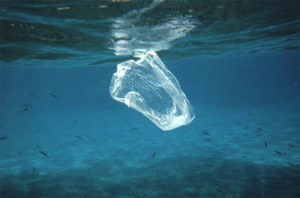
Some types of plastic are more buoyant than others, and not all plastic floats.
Microplastics have been discovered inside the Great Pacific Garbage Patch at every level under the water level, all the way down to the ocean floor.
Scientists estimate that up to 70% of the plastic debris in the GPGP will sink to the bottom of the ocean.
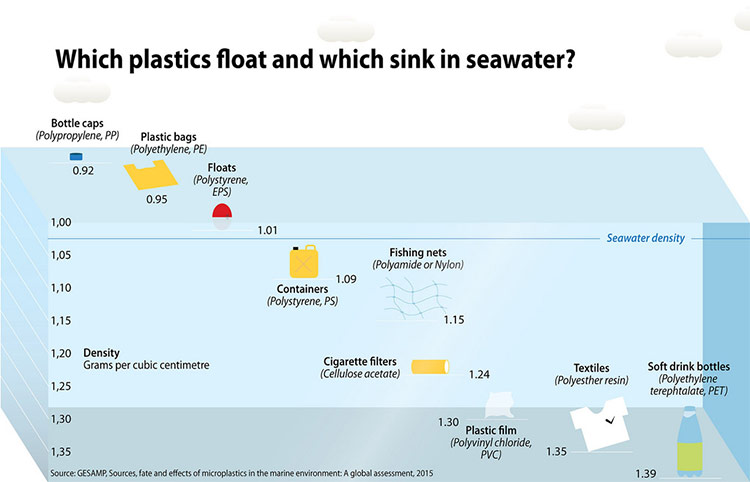
Plastic bottles tend to sink to the bottom quite quickly, whereas plastic bags will usually float on the surface of the water. Other types of plastic can be suspended, neither rising to the surface nor sinking to the sea floor.
8. Plastic will account for roughly 74% of the diet of sea turtles that enter the area
Key takeaways:
-
Researchers discovered that around 74% of the diet of sea turtles within the GPGP consists of plastic debris.
-
Its size and appearance often lead animals to mistake plastic for food, leading to malnutrition and other health issues.
-
Approximately 700 species have encountered marine debris.
-
17% of the species affected by plastic are listed on the IUCN Red List of Threatened Species.
-
Marine animals that consume this debris are also ingesting the harmful chemicals that are attached to the plastic.
-
Plastic bags can be particularly tempting to sea turtles, as they closely resemble a key part of the turtle’s diet: jellyfish.
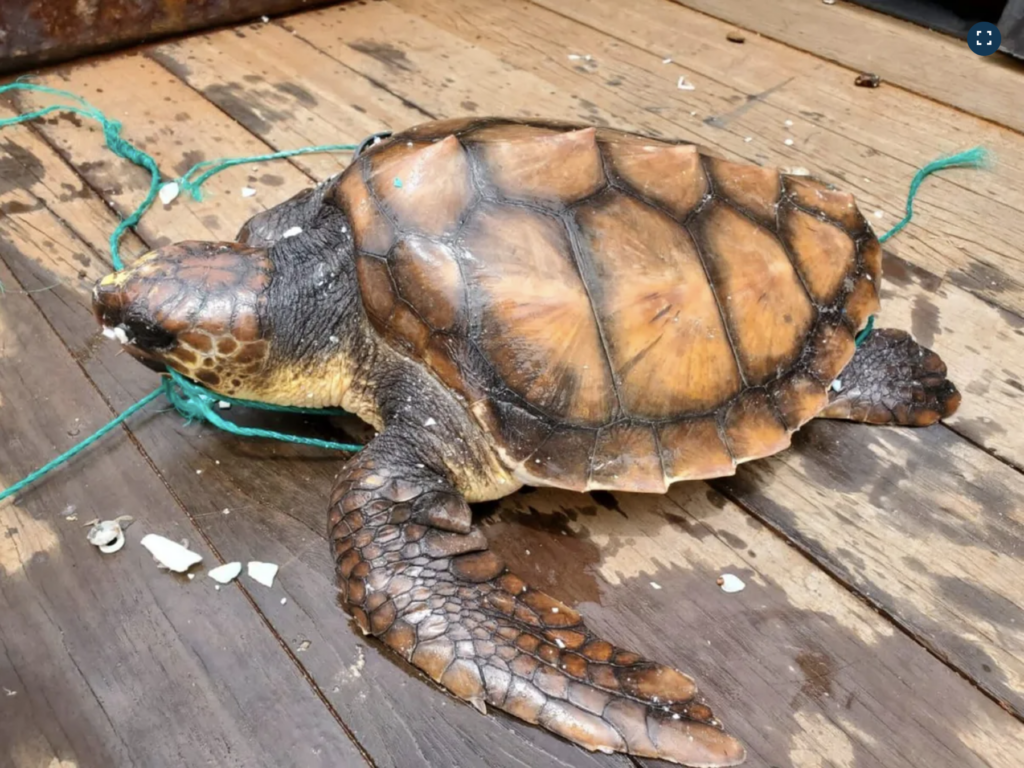
Because of the sheer volume of plastic within the Great Pacific Garbage Patch, it should come as no surprise that marine life that venture into the area end up ingesting plastic. In fact, researchers discovered that around 74% of the diet of sea turtles within the GPGP consists of plastic debris.
Plastic has become an ever-present presence in the pacific ocean, posing significant risks to marine life. Its size and appearance often lead animals to mistake it for food, leading to malnutrition and other health issues. Additionally, marine species are at risk of entanglement, which disrupts their behavior and overall well-being, endangering their existence. Research has revealed that approximately 700 species have encountered marine debris, with ocean plastic accounting for 92% of these interactions. Alarmingly, 17% of the species affected by plastic are listed on the IUCN Red List of Threatened Species, highlighting the grave impact of plastic pollution on biodiversity.
As much as 84% of the plastic debris discovered in the ocean contains at least one Persistent Bio-accumulative Toxic (PBT) chemical. Consequently, marine animals that consume this debris are also ingesting the harmful chemicals that are attached to the plastic.
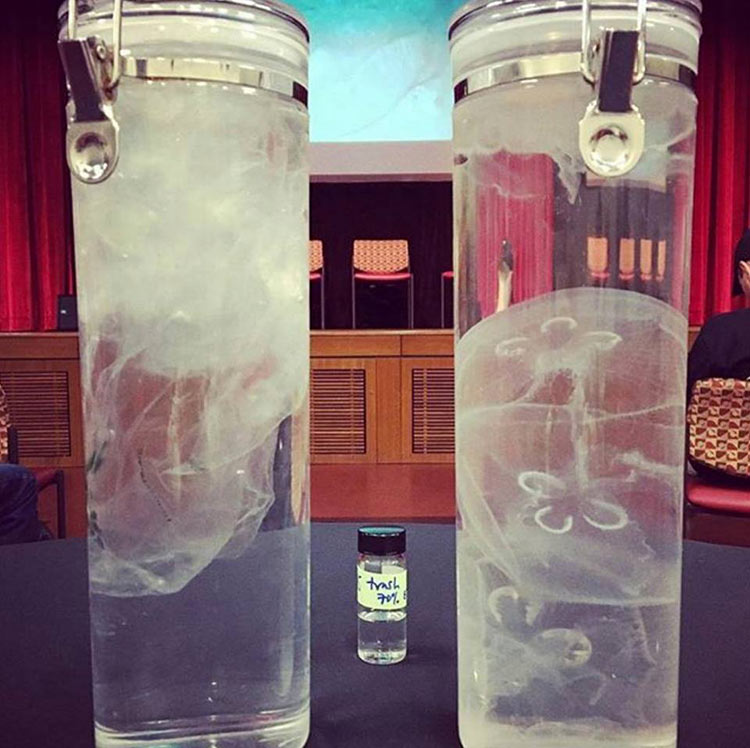
Plastic bags can be particularly tempting to sea turtles, as they closely resemble a key part of the turtle’s diet: jellyfish. The picture above illustrates how similar they look when they are submerged in water.
A scientific study carried out by a team in Japan found that Loggerhead Turtles ate plastic 17% of the time they encountered it.
As well as ingesting it, sea turtles are also in danger of becoming entangled in plastic. Having their flippers wrapped in plastic can often result in death, as they lose the ability to swim and feed themselves.
9. It contains plastic that is decades old
Key takeaways:
-
Every piece of plastic that has ever been produced is still in existence today.
-
Scientists don’t even know if plastics will ever truly disappear.
In the grand scheme of things, plastic has only been around for a very short amount of time. It was only in the 1950s that plastic began to be mass produced.
Every piece of plastic that has ever been produced is still in existence today. A plastic toy you played with when you were a child is still out there somewhere – perhaps it now exists in a million tiny pieces, but the plastic is still plastic, and it’s not going away any time soon.
Scientists don’t even know if plastics will ever truly disappear. You’ll read estimates online of 500 years or 1000 years, but they are just that: estimates.
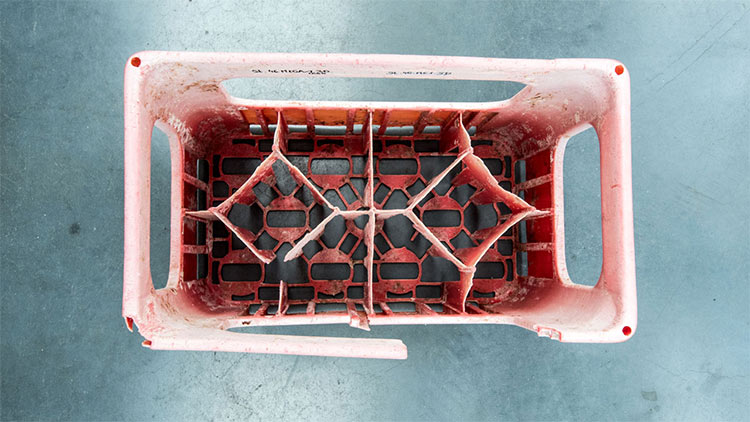
This plastic crate was found in the Great Pacific Garbage Patch. It was found to have been manufactured in 1977.
It may be a little frayed and a little washed out, but it is still very much recognisable as a crate. It still looks strong.
Pieces from this crate have obviously broken off. These pieces will then break into smaller pieces, which will break into smaller pieces. And on and on this process will go, century after century.
10. The largest ocean cleanup in history is underway to try to remove plastic from the ocean
Key takeaways:
-
The Ocean Cleanup is an initiative founded and lead by Boyan Slat.
-
In 2013 Slat founded the non-profit organisation ‘The Ocean Cleanup’.
-
Thanks to crowdfunding and donations from Silicon Valley entrepreneurs, The Ocean Cleanup raised over $31.5 million USD to launch the biggest ocean cleanup in history.
-
The Ocean Cleanup is developing and scaling technologies to rid the world’s oceans of plastic.
-
Over System 002’s first 12 trips to the GPGP, the total cumulative catch amounted to 193,832 kg of plastic.
-
Their aim is to have removed 90% of floating ocean plastic by 2040.
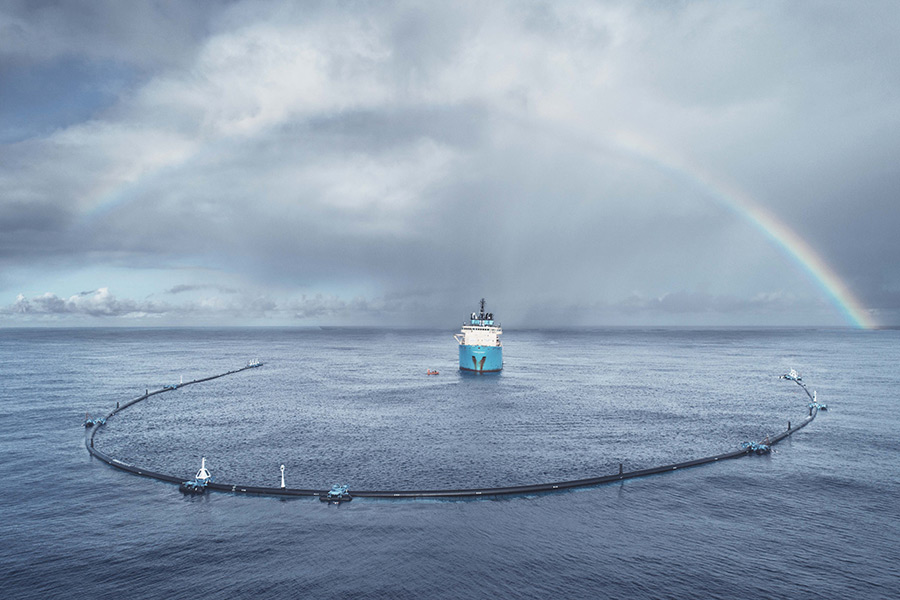
Their aim is to have removed 90% of floating ocean plastic by 2040.
The Ocean Cleanup is an initiative founded and lead by Boyan Slat. Slat became interested in the issue of plastic pollution as a 16-year-old boy scuba diving while on vacation in Greece. He was shocked by the amount of plastic he found while diving and set about working on a potential solution.
Showing incredible drive and ingenuity, in 2013 Slat founded the non-profit organisation ‘The Ocean Cleanup’.
Thanks to crowdfunding and donations from Silicon Valley entrepreneurs, The Ocean Cleanup raised over $31.5 million USD to launch the biggest ocean cleanup in history.
The Ocean Cleanup system consists of a 600-meter long floating boom, which collects plastic debris into a containment area.
Once the debris has been contained, it will then be picked up by a ship, which acts as a ‘garbage truck of the sea’.
The goal of the Ocean Cleanup is to remove 50% of the plastic within the Great Pacific Garbage Patch within five years before moving on to tackling the debris in the other ocean gyres.
The Ocean Cleanup commenced in October 2018. We’ll post more updates as they come in.
Ocean Cleanup Update:
SYSTEM 002 IN 2022
After demonstrating Proof of Technology the previous year, 2022 was all about cleaning. It was a successful year for The Ocean Cleanup in the GPGP:
System 002: 2022 in numbers
- 8 trips into the GPGP on cleaning operations
- Over 150 days at sea (including transit)
- 153,000 kg of plastic removed from the GPGP in 2022
- 4 consecutive trips with catch totals over 25,000 kg
- 99.9% of catch comprising only plastic
Over System 002’s first 12 trips to the GPGP, the total cumulative catch amounted to 193,832 kg of plastic
Risks to human health and the economy
Once plastic enters the marine ecosystem, there is a potential for it to contaminate the human food chain, posing risks to human health. Additionally, the efforts and resources required for cleaning and removing ocean plastic have imposed substantial financial burdens on society.
Marine debris poses a disruption to the marine food webs within the North Pacific Subtropical Gyre. Accumulation of microplastics and other waste on or near the sea surface obstructs sunlight from reaching the plankton and algae residing below. These algae and plankton are vital autotrophs, responsible for sustaining the marine food web by producing nutrients through photosynthesis.
When the communities of algae and plankton are endangered, the entire food web can undergo significant changes. Species like fish and turtles that rely on these primary producers for sustenance will face food scarcity. As a consequence, apex predators such as tuna, sharks, and whales, which depend on these intermediary species, will also experience a decline in their food supply. Ultimately, this can lead to reduced availability and increased cost of seafood for human consumption.
Impact on the Human Food Chain
Plastics introduce chemicals into the marine food chain through a process known as bioaccumulation. As these chemicals transfer from the plastic-consuming organisms to their predators, including humans, they can pose risks to human health.
Impact on the Economy
A collaborative study with Deloitte estimates that the annual economic costs associated with marine plastic range from $6-19 billion USD. These costs arise from the negative effects on tourism, fisheries, aquaculture, and the expenses incurred in governmental clean-up efforts. It’s important to note that these costs do not include the impacts on human health and the marine ecosystem, which highlights the need for further research. Consequently, intercepting plastic waste in rivers proves to be a more cost-effective solution compared to dealing with the downstream consequences.
What to do about the marine debris problem in the pacific ocean
Consensus among scientists and explorers emphasizes that the most effective approach to address the Great Pacific Garbage Patch is to reduce or eliminate the usage of disposable plastics while promoting the adoption of biodegradable alternatives. Various organizations, such as the Plastic Pollution Coalition and the Plastic Oceans Foundation, are actively leveraging social media and implementing direct action campaigns. Their efforts aim to assist individuals, manufacturers, and businesses in transitioning away from harmful disposable plastics towards biodegradable or reusable materials. By fostering widespread awareness and advocating for sustainable choices, these organizations are playing a crucial role in combating plastic pollution.
In april 2023 the G7 countries released this statement: “We are fully committed to stopping plastic pollution with the aim of reducing it to zero by 2040,” as statements go that is as good as it gets, however, without a realistic plan on how to achieve that result, it remains to be seen how much worth that statement truly is.
The Great Pacific Garbage Patch FAQ
The patch covers an estimated surface area of 1.6 million square kilometers. That’s twice the size of Texas, or three times the size of France. With the total mass close to 100,000 tonnes.The patch cannot be seen from space, as is sometimes claimed.
The sheer size of the area makes it logistically difficult to locate and extract all the debris. It also contains microplastics that are dispersed throughout the water column, making it challenging to collect them efficiently.
Yes, thriving communities of coastal creatures, including small crabs and anemones, have been discovered by scientists.
More Resources:
Pollutants in Plastics within the North Pacific Subtropical Gyre
The impact of debris on marine life
What and Where Are Garbage Patches?
Algalita.org – An organization that aims to educate people about plastic pollution.
Evidence that the Great Pacific Garbage Patch is rapidly accumulating plastic
